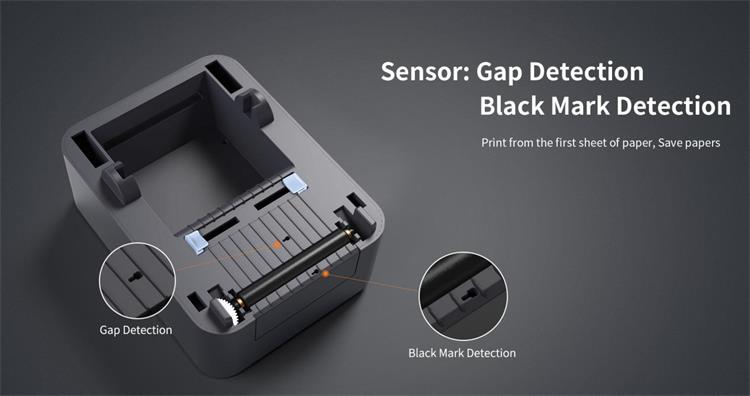When in the market for label printers, one often comes across a variety of label types, it’s common to encounter diverse label types, including continuous paper, gap paper, and notably, the "black mark labels." Many modern label printers highlight their advanced black mark detection capabilities. This raises two essential queries: What is the significance of the "black mark"? And how does the black mark detection function enhance the performance of label printers?"
This article aims to demystify the concept of ’black mark’ and delve into the pivotal role of black mark detection in optimizing label printer functionality.
Understanding the Black Mark
A black mark is essentially a black line found on the reverse side of a label, acting as a positioning guide. Its primary function is to aid the label printer in precisely identifying and pinpointing the commencement of each label, ensuring the accuracy of the printed content. Black mark labels are predominantly crafted from thermal adhesive materials, encompassing vinyl, PVC, cloth labels, synthetic paper, and waterproof thermal paper. These labels are extensively utilized across sectors such as retail, logistics, healthcare, manufacturing, and the fashion industry.
The Mechanism Behind Black Mark Detection
Label printers discern the black mark on a label’s reverse side using an in-built reflective black mark sensor. The underlying principle is straightforward: as the label progresses through the printer, the sensor’s light source illuminates the black mark. Given black’s inherent property of absorbing light, the light reflected back to the sensor diminishes. This change in light intensity is detected by the sensor, which then signals the printer about the onset of the next label, ensuring meticulous positioning.

Alternative Methods of Label Positioning
Beyond black marking, the market offers continuous and gap papers. Continuous paper is essentially an uninterrupted roll, granting users the flexibility to print labels of diverse lengths, such as cloth labels or packaging labels. These labels predominantly depend on roller movement for accurate positioning. Conversely, gap paper features a minute space between each label, all of which are of a pre-defined size. Gap paper typically employs a penetrative gap sensor to detect the void between labels, facilitating precise positioning.
The Edge of Black Mark Positioning
The standout advantage of black mark positioning is its unparalleled accuracy. Given that the black mark serves as a clear, discernible indicator, thermal label printers can flawlessly determine the start of each label. For instance, during rapid printing sessions, black marks ensure that every label is printed with precision, eliminating any chances of overlaps or omissions.
In comparison, continuous and gap papers might occasionally encounter positioning challenges. For gap paper, especially when dealing with round or irregularly shaped labels, inconsistent or varying gaps can pose detection challenges for sensors. Continuous paper’s positioning largely hinges on the roller’s movement, and any wear or instability can compromise label positioning.
iDPRT’s state-of-the-art thermal barcode label printer is equipped with a plethora of positioning technologies. For instance, the iD4S desktop thermal printer not only supports black marking but also incorporates other high-precision sensors, including gap sensors and paper-out sensors. These collective features guarantee accuracy and fluidity in every print cycle.

iDPRT’s barcode label printers have garnered widespread acclaim across domains like retail, apparel, logistics, warehousing, healthcare, and manufacturing. They excel in printing a diverse range of labels, from price tags and shelf labels to express waybills, medication labels, and product labels. Moreover, they are adept at handling specialized label materials like cloth labels and vinyl. Regardless of the specific requirement, iDPRT stands out as a beacon of high-precision printing solutions for its users.







